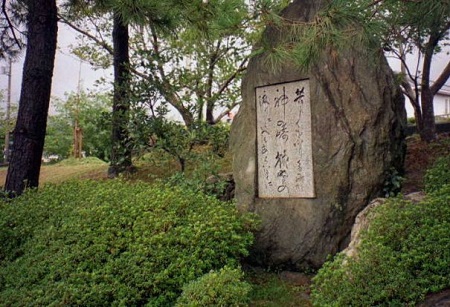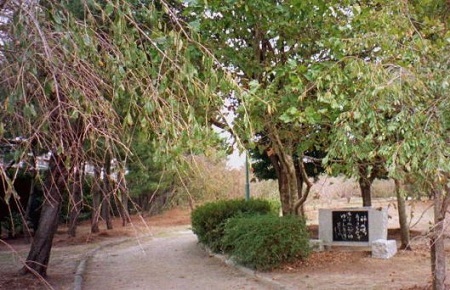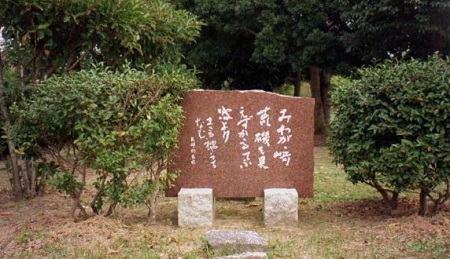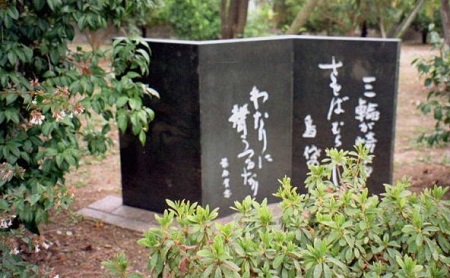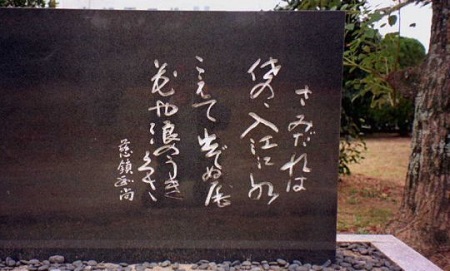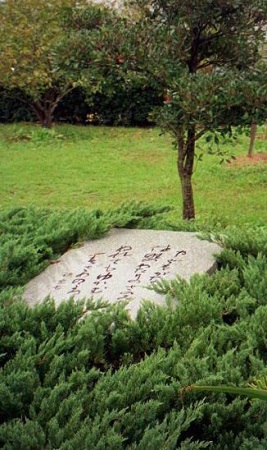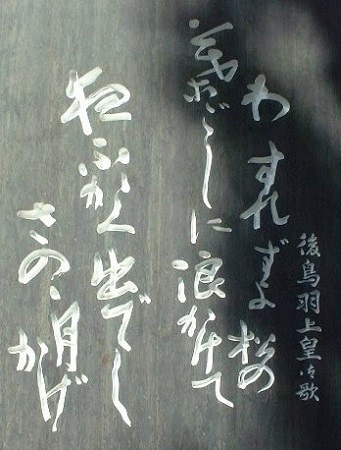|
It is now Heisei 22 (2010), about 40 years after Kyozo Wozumi died.
Shall we get a bird's-eye view of the present and the past of Miwasaki,
his hometown?
1. Koyazaka Slope, a Kumano Ancient Road
Miwasaki is a seaside town over a hill from the urban area of Shingu, the
prefectural border city of Wakayama prefecture with Mie prefecture. It
is also not far from the southern end of Kii Peninsula.
Since Showa 35 (1960) when Emperor Showa traveled from Ise in the direction
of Osaka via Kii Peninsula by car, National Road 42 was improved and wholly
paved. It made the traffic all the way along the seashore of the peninsula
so convenient.
But as for this village surrounded by mountains and the sea, it remains
the past in several views, which has some peculiar atomosphere.
One of them is the narrow mountain pass heading for the center of Shingu
City separated from National Road 42, visible of the Sea of Kumano downward
all the way. It is called Koyazaka Slope of 3-km distance, which is among
Kumano Ancient Roads (Kumano Kodo).
Kumano Kodo, Pilgrimage Routes connecting Sacred Sites in the Kii mountain
Range, was designated as the World Heritage Site in 2004 by UNESCO, by
the name of "Sacred Sites and Pilgrimage Routes in the Kii Mountain
Range".
Among the seven Roads, Nakaechi Pilgrimage Route contains Koyazaka Slope,
located in a part between Kumano Hayatama Grand Shrine and Kumano Nachi
Grand Shrine.
Since Heian Period (794-1185) considerable numbers of high ranking courtiers
from such old capitals as Kyoto or Nara visited Kumano Sanzan (Kumano Three
Major Shrines). I am interested in whether they walked along this mountain
pass during those old days or not.
The mountain pass with rock faces here and there surrounded by bamboo groves
and thickets is covered mostly with moss. When you pass by around the area
of mysterious atmosphere and then a calm view of the Sea of Kumano comes
out below, you could be willing to feel such ancient times.
Lucky or unlucky, there are few sightseers until now. This may let this
pass be a little-known spot among the World Herritage spots in this district.
During the walk through Koyazaka Slope, you can see several highlights
* Stone-Paved Path
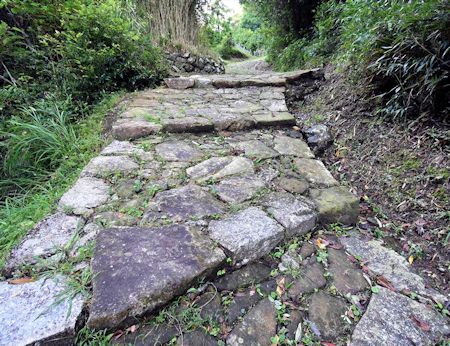
This is the Miwasaki-side entrance of the slope. The stone-paved path is
less than 100 meters long, but when you just step into it, strangely you
must notice busy cries of birds. And also harsh voices of crows, maybe
descendants of Yata-garasu, a mythical raven with three legs who aided
Emperor Jimmu on his eastern expedition.
* Observatory of the Sea of Kumano
About 10-minute walk from the entrance there is a sign of the obsevatory.
Going to the right through an ivy-tangled bush by its direction, the view
widely opens toward the Pacific Ocean.
It is a small space with a sheer cliff on the edge, where an observatory
made of Japanese cypress is built.
Up the stairs and looking down below, large and small waves of the Sea
of Kumano are seen beating against the shore and splashing.
The look is different depending on whether the sea is rough or calm, but
the view with several small islands near and away is always impressive.
Looking up from the wild waves below the cliff, the view with the two small
islands in the center of the sight is especially a feast for the eyes never
to be overlooked.
* Mitarai Monument near Hirotsuno Entrance
Coming near Hirotsuno exit of Shingu side, the view spreads out and you
are at the spot where Ojigahama beach and the Sea of Kumano can be seen
wholely.
There are two Mitarai monuments there on the left of Koyazaka Slope, carved
each with the Buddhism prayer "南無阿弥陀仏" (namu-ami-da-butsu).
The whole scenery from here downward is what tourist brochures praise as
the most marvelous sightseeing spot around. Besides, the view, the waves
washing against the gravel shore of Oji Beach are making a clear and rustling
sound.
2. Sand Beach and Two Small Islands
* Sand Beach
A sand beach is widened on the east side of the overpass from the Miwasaki
fishery cooperative to Suzushima Island. This beach, called "hama"
locally, is firmly connected with the people's life in Miwasaki town.
Near the overpass on the sand, unloaded fishing boats are in line side
by side , sea vegetables are hung out, and several fishermen are often
mending fishnets.
The east side from here is a beach resort and a children's playground in
summer. But don't expect too much cheerful atmosphere because there are
no stores nor facilities around.
In the fall, the sand beach is the stage of Whale Dance, the main event
of the village festival, where young men wearing a brilliant dress dance
matching with Japanese flutes and drums.
In winter, it is the place of an open-air fire for ama or female divers.
They warm themselves and eat baked sweet potatoes.
The sand not pure white nor smooth like at the beaches of Nachi and Shirahama,
but rather gray and rough. Small stones and various seashells washed by
waves are scattered here and there.
When you are here, never fail to be barefooted and feel the tiny graveled
sand with your feet. Then enjoy throwing a small flat stone to the sea
for the triple jump or more.
* Suzushima and Kushima Islands
Two small islands are floating right in front of Miwasaki Fishery Cooperative.
They are Suzushima and Kushima Islands.
Firstly Suzushima Island. It is connected to the wharf by an overpass.
It takes only less than 10 minutes to walk around, but you may enjoy something
simple and tasteful. Rugged rocks, pretty flowers, an aloof pine tree,
waving shores, ..., they are all natural, which could make you enjoy its
own peculiarity.
A distant view of the mountains from this island is not bad. It has a different
taste from other sightseeing places.
Kushima Island is connected with Suzushima by the caisson bridge of 200
meters. Its view from the hole of Suzushima is interesting.
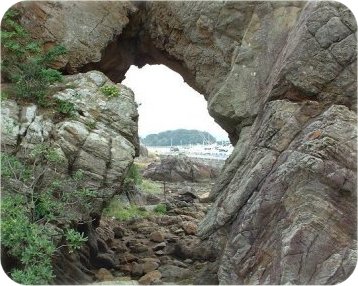
The offshore view on the bridge is also superior. The beating waves from the Pacific Ocean could convince you of the rough state of the shore.
Kushima Island is famous for crinums, the flower of Shingu City. They come
into full blooms in summer.
In this island other various plants of a national treasure grow in colonies,
so people with such a hobby must wish to stay here long.
The small shrine enshrines the gardian angel of fishermen.
This island, fairly larger than Suzushima, is also left as it is, which
may rather be boring but, I may say so, this atmosphere would embody the
climate of Miwasaki town.
3. Village Festival and Whale Dance
The greatest annual event in Miwasaki is the village festival forever.
September 15 is the day of a grand festival of Hachiman Shrine, and for
the day the town atmosphere gets livened up more and more from two days
ago with several events like tengu dance.
Festival music guys parade through the town, and in front of some houses
a boy of lower grade of elementary school selected for the year with a
tengu mask dances with the help of their lively music.
In the morning of the festival day, tengu dance is lasting somewhere until
the beginning of the main parade show at 10:00.
At the time, the grand parade starts in front of Hachiman Shrine and runs
until the fishery port for over 1km.
The parade consists of such festive floats as Ebisu, Daikoku and Nijihiko.
Children run pulling each of them and repeat to hit them one after another,
and the parents on the road side cheer on at the top of their voices, which
excites the whole town the most.
Early in the afternoon, at the top of excitement, the local folklore "Whale
Dance" starts on the sand beach.
It is always the main stage of the village festival. Many spectators from
neighboring towns flock together for this event.
In fact until lately a whale's spout was sometimes seen offshore in this
town Miwasaki.
On the stage young men, wearing such a dress of fishermen of the old days
with a spear dashing for a whale, sing and dance matching the lively sound
of flutes and drums.
The whale dance consists of two dances. One is "Denchu Odori"
that a dozen men dance in a circle, and another is "Aya Odori"
that they sit on goza (rush mat) and dance in a posture throwing a tube.
"Oise-san" (Ise Grand Shrine and the surroundings) comes out
in both of the lyrics.
"Denchu Odori"
With a sun-disc folding fan in both hands, a brilliant headband on head
and wearing a festival dress, they dance with the musical accompaniment
of flutes and drums.
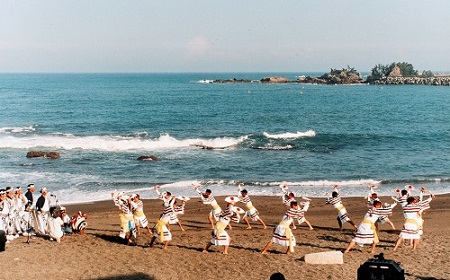
突いたや三輪崎組はサ
(ハア三輪崎組はサ)
親もとりそえ 子もそえて
………………
船は着いたや五ヶ所の浦にサ
(ハア五ヶ所の浦にサ)
いざや参らん 伊勢さまへ
(ソリャ 一国二国三国一ジャー)
"Aya Odori"
Sitting on each rush mat, young guys with a folding fan in the left hand
dance in a motion of throwing a tube with beads in it. Everytime they do
this motion, the sound of beads echoes so clearly.
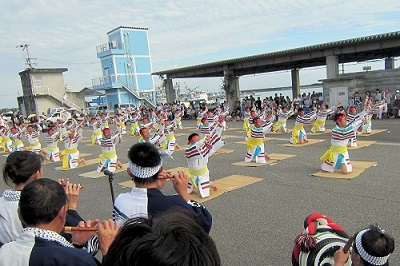
今日は吉日きぬた打つ
(アヨーイヨイ)
今日は吉日きぬた打つ
お方出てみよ子もつれて
(アーきぬた)
………………
伊勢のようだで吹く笛は
(アヨーイヨイ)
伊勢のようだで吹く笛は
響き渡るぞ宮川へ
(ヨヨイエー)
4. Miwasaki and Sano in Manyoshu
(the Oldest Existing Collection of Japanese Poetry)
The following is taken from the Manyoshu part of the English Wikiedia and
extracted a little.
"The Man'yōshū (万葉集, literally "Collection of Ten Thousand Leaves")
is the oldest existing collection of Japanese poetry, compiled sometime
after AD 759 during the Nara period. The anthology is one of the most revered
of Japan's poetic compilations.
It contains many poems from much earlier, many of them anonymous or misattributed
(usually to well-known poets), but the bulk of the collection represents
the period between AD 600 and 759."
This collection contains 4,207 tanka (short poems) with many other poem
styles. And in it, several tanka related to remote villages Miwasaki and
Sano in Wakayama prefecture are included. Unbelievable, but it is the fact
even in such a situation then.
The Imperial Court, or the cultural center in Japan, was in Nara then Kyoto
of Kinki Region those days far from the remote villages even in the same
district.
The worship of the Kumano Three Shrines (Kumano-sanzan) spread to court nobles of the days, pilgrimages over there became popular, and many of nobles visited them: the spectacle of their advancing on a narrow mountain trail in a row was called "ari no kumano-mode" (ants' pilgrimages to the Kumano-sanzan).
The Japanese history comes down to the early modern times of Edo &
Meiji period (1603-1912), when Kumano-sanzan and Mt. Koya attracted pious
people as "the Sacred Sites in the Kii Mountain Range". But as
for a remote fishing village in the out-of-the-way corner of the southern
end of Kii Peninsula, no people took any notice of the village any longer.
It can be well said in a commonsense.
However, back to the days of the oldest existing collection of Japanese
poetry, there were most probably a considerable number of poets around
the capital far north from Kii Mountains visited Nachi Grand Shrine and
Hayatama Grand Shrine as well as Hongu Grand Shrine.
Among them some poets seem to have got interested in such remote villages
as Miwasaki and Sano, and so it could be said that several poems related
there are in that collection.
At the border of Miwasaki with the west beach touching Sano, Kuroshio Park
is found, which is a place of relaxation for seniors and a playground for
children.
Here and there in the park you can see the following eight monuments of
tanka poems of the old days. Most of them are in Manyoshu Collection.
That's about all of the introduction of Kyozo Wozumi's hometown Miwasaki
for now.
|


